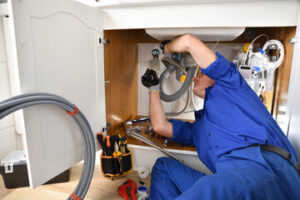Clogged drains are a major nuisance, especially in the most used areas of a home. They can create foul odors and affect water and waste flow.

Regular Drain Cleaning is essential to prevent clogs and keep your plumbing system healthy. But it’s important to know when DIY methods are not enough and when it’s time to call a plumber!
Baking soda and vinegar are household items that can be effective in cleaning many types of clogs. The fizzing action of this combination can lift grease and other clog materials and is often less harmful to pipes than store-bought liquid drain cleaners.
The chemical reaction that happens when these two ingredients are combined is simple — baking soda (sodium bicarbonate) is a base while vinegar is acidic. The reaction that results when they interact creates carbon dioxide gas, which can help to break down clogs and clean drains. However, it is important to note that the acid in vinegar can damage certain types of pipes over time if used frequently.
When using baking soda and vinegar to clean a drain, it is important to be sure that you are working in a well-ventilated area and that children and pets are kept away from the work area. Also, it is best to use this method before going to bed, as the mixture can be dangerous for your pipes if left standing overnight.
Pour a cup of white vinegar into your drain, followed by 1/2 cup of baking soda. Allow the mixture to sit in your drain for about an hour. Once the mixture has had some time to work, pour a pot of boiling water down your drain. This should cause a vigorous bubbling reaction that helps to clear away the clog and remove any remaining baking soda.
If the baking soda and vinegar method does not seem to work on your clog, try combining lemon juice and cream of tartar to make an effective homemade drain cleaner paste. Apply the paste to your clogged drain, let it sit for a few minutes, and flush with hot water.
For more stubborn clogs, you can also try a mixture of equal parts salt and baking soda. Mix the two ingredients together, then cover your drain with a cloth or drain plug and let it sit for about an hour. This is an excellent method for removing hair buildup from shower and bathtub drains.
Other natural drain cleaners include brewed coffee grounds, which can be used to unclog toilets, and lemon peels, which can also be used to clear a drain. These methods are generally less effective than the baking soda and vinegar method, but they may still be able to help with more minor drain clogs.
Chemical Cleaners
Chemical drain cleaners contain acids or bases that create a reaction with the clog to dissolve it. They are available in liquid form and can be poured down the drain. They are typically effective at dissolving hair, sludge and other organic materials that are often the cause of a simple drain clog. Chemical cleaners are also helpful in breaking down some types of grease clogs. They usually work by converting the fats and oils in the clog into soap-like substances that can be easily washed away.
Acid-based chemical drain cleaners work by creating a chemical reaction with hydrochloric or sulfuric acid to dissolve organic material and break down clogs. You can find this type of cleaner at most hardware stores.
These cleaners can damage your pipes and drain lines if used too often or in large amounts. They can corrode PVC and older metal pipes. They can also release toxic fumes that can be harmful to your health and aggravate preexisting respiratory problems.
Most commercially available acid-based drain cleaners contain sulfuric acid that can wear down your pipes over time. This can result in holes and cracks that allow water to leak out of the system. These leaks can be very difficult and costly to repair.
Base-based chemical drain cleaners are usually made of sodium hydroxide (lye) or potash. These are more gentle than acidic cleaners and can be found at most home improvement or grocery stores. They can be effective at breaking down some grease clogs, but they don’t always work on the more stubborn ones.
The best way to avoid using chemical drain cleaners is to prevent clogs from occurring in the first place. This can be done by regularly checking your drains for obstructions and cleaning them out as needed. If you do encounter a serious blockage, it’s important to call a plumber for help rather than trying to use a chemical cleaner. A professional can use a variety of tools to remove even the most stubborn drain clogs without damaging your plumbing. This will save you money and ensure your clog doesn’t return.
Enzymatic Foam Cleners
Enzymatic cleaners use the natural catalytic effect of enzymes to break down organic stains. This makes them more environmentally friendly and biodegradable compared to traditional chemical cleaners, while still being effective. Enzyme cleaning products also offer several safety advantages. The most important factor to consider when selecting an enzymatic cleanser is the type of enzymes used. Different enzymes can break down organic stains in different ways, so it is critical that you choose one that targets the specific contaminants you need to clean.
Enzyme foam cleaners are a great way to start the pre-cleaning process for surgical instruments, endoscopes, and other reprocessable medical devices. They are formulated to spray a foam on soiled instruments and equipment, making it easier for technicians to apply the cleaner properly. The foam forms quickly and covers the entire instrument to prevent bacterial adhesion. The enzymatic cleanser then starts to attack the bio-burden on the surface of the instrument, reducing the overall cleaning time and the risk of contamination during reprocessing.
A low-foaming enzymatic cleaner such as Vigor Low-Foaming Enzymatic Cleaner will loosen dried debris, blood, protein, and mucin deposits that can clog drains. It is safe on a wide range of materials and does not require high concentrations or temperature settings to be effective. It also provides corrosion inhibitors that prevent the build-up of rust on stainless steel and other metal instruments.
Enzymatic cleaning solutions are also commonly used in animal care facilities to help prepare equipment and utensils for sterilization or high-level disinfection. They can be used as presoaks or in the first stage of automatic cleaning (such as in an ultrasonic washer or automated endoscope reprocessor). When purchasing these solutions, be sure to review their IFU to ensure that they meet your facility’s requirements. This includes ensuring that they are stable over a variety of temperatures and are compatible with your reprocessing system’s water quality.
Call a Plumber
When drain cleaning solutions like baking soda and vinegar, chemical cleaners, or enzymatic foam cleaners fail to work on your clogged pipe, it may be time to call a plumber. These plumbing professionals have access to tools that can reach deep within your pipes and clear even the most stubborn clogs, including those caused by hair, grease, or other organic waste. They can also perform routine maintenance and inspections to prevent future clogs, saving you time, money, and frustration.
Persistent clogs could indicate a bigger issue that requires professional attention, such as damaged or broken pipes or a blocked sewer line. Trying to use a plunger on such a blockage could result in the walls of your pipes being bent or crushed, leaving you with a much more expensive and extensive problem.
Some commercially-available drain cleaners, especially those that are corrosive, leave residue on the walls of your pipe that can cause more buildup over time. These chemicals can also lead to a corrosion of your pipes, especially those made of metal. These residues can then attract more debris and create a new, worse clog, making your problem even bigger.
Using an auger or a drain snake can also cause damage if not used properly. Attempting to use one without proper training can bend the walls of your pipes or break them completely, leaving you with a serious and dangerous leak. The right plumbers will have specialized hoses and video inspection equipment that can safely clear your pipes of any obstructions while minimizing damage.
Another way to unclog your drain quickly is by pouring boiling water down the drain in multiple stages, letting it sit for a few seconds between each one. This method works well for removing hair and can be repeated frequently to prevent clogs from forming.
If you find yourself constantly dealing with clogged drains, it’s important to contact a plumbing professional. Not only will they be able to resolve your clogs faster, but they can help you establish a preventative maintenance plan to keep your pipes healthy and happy for years to come.
